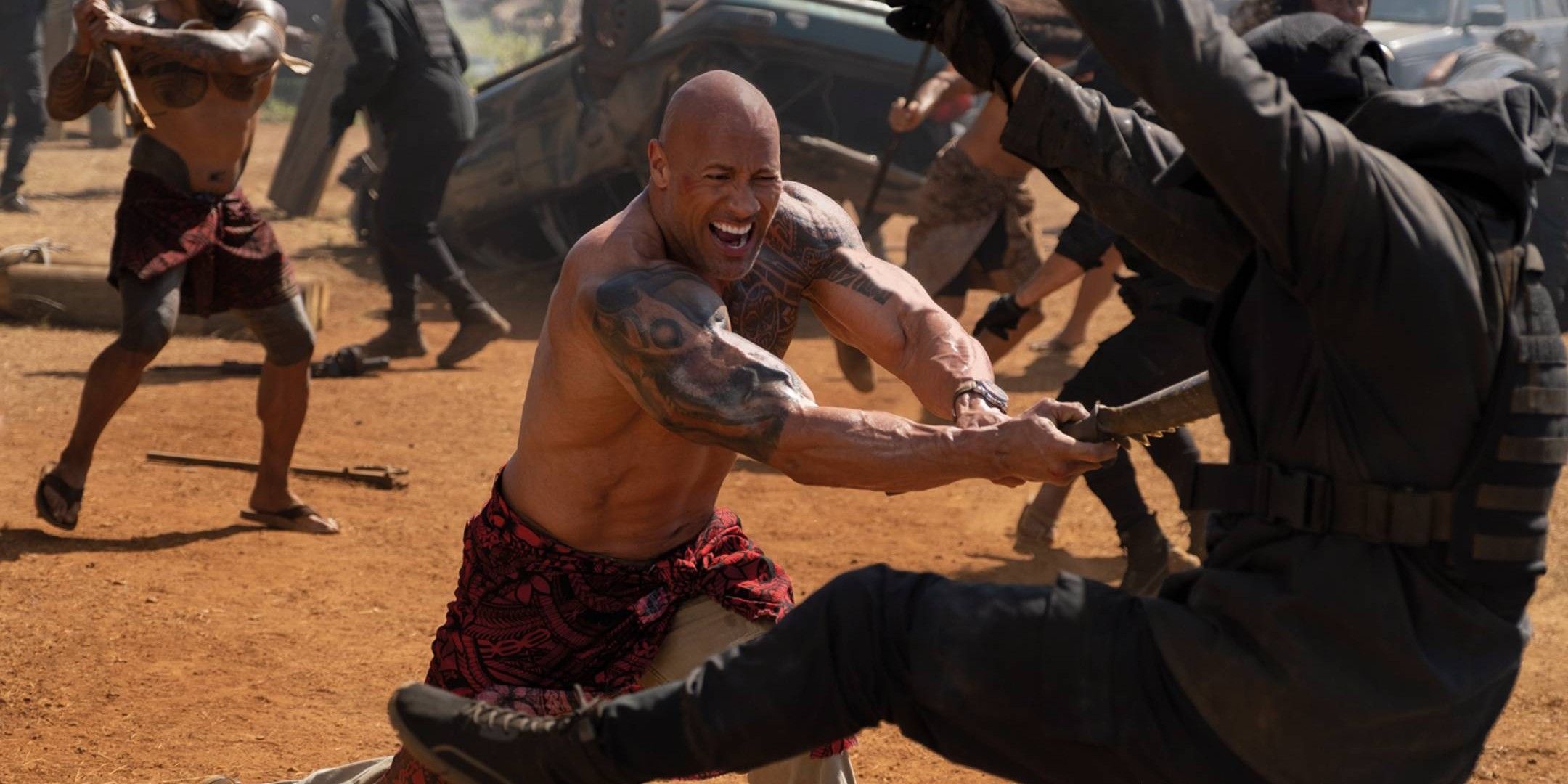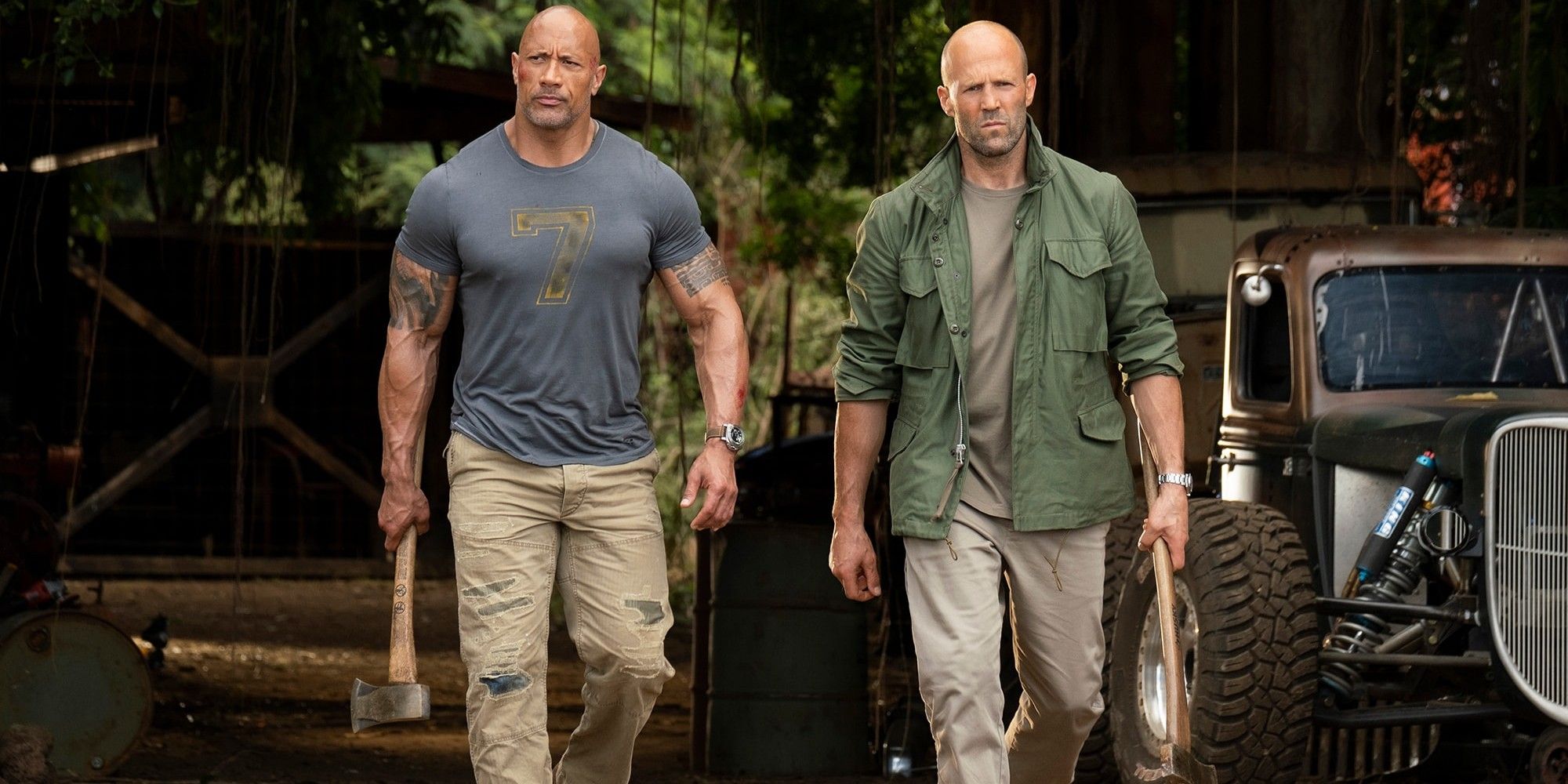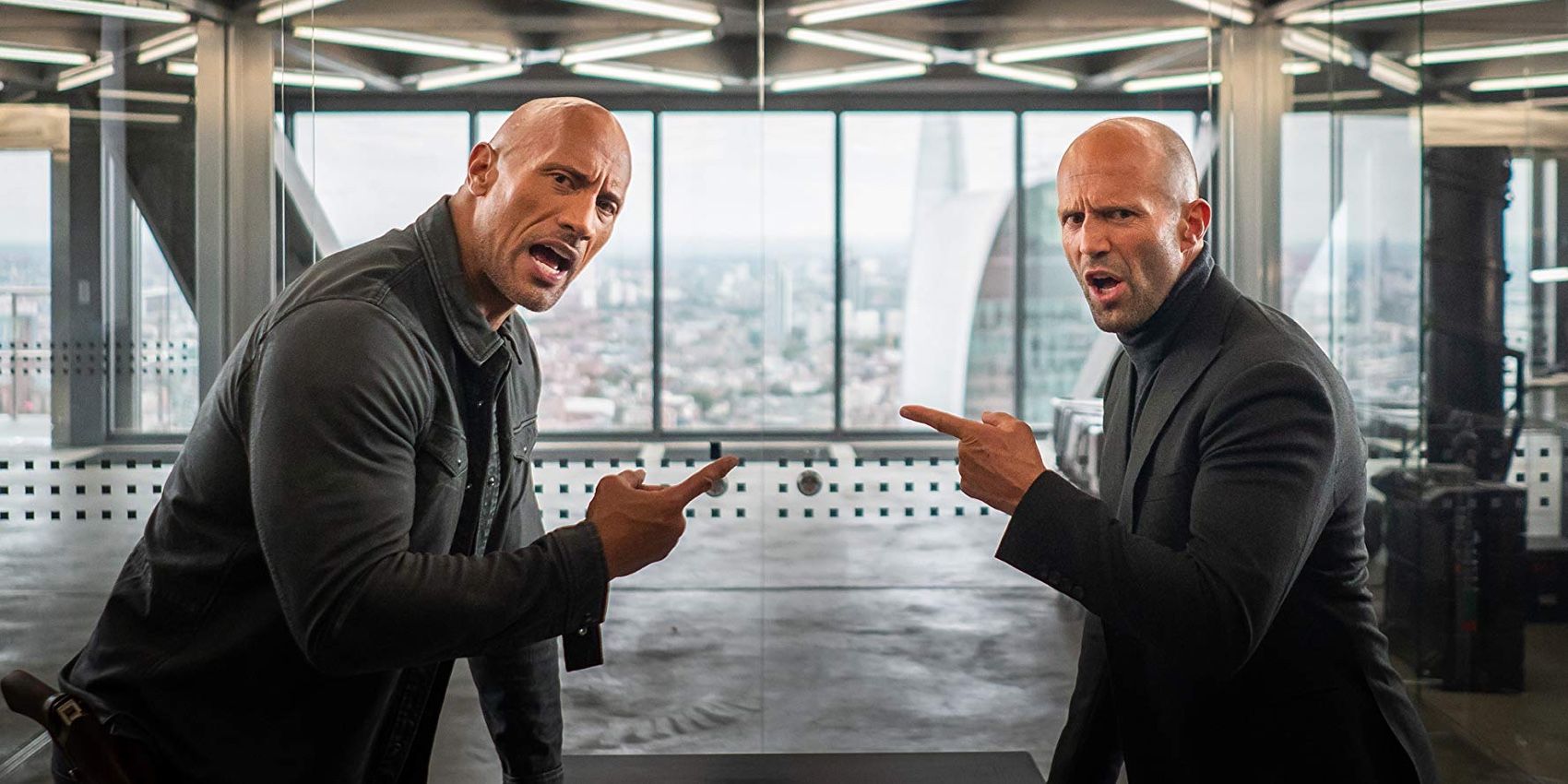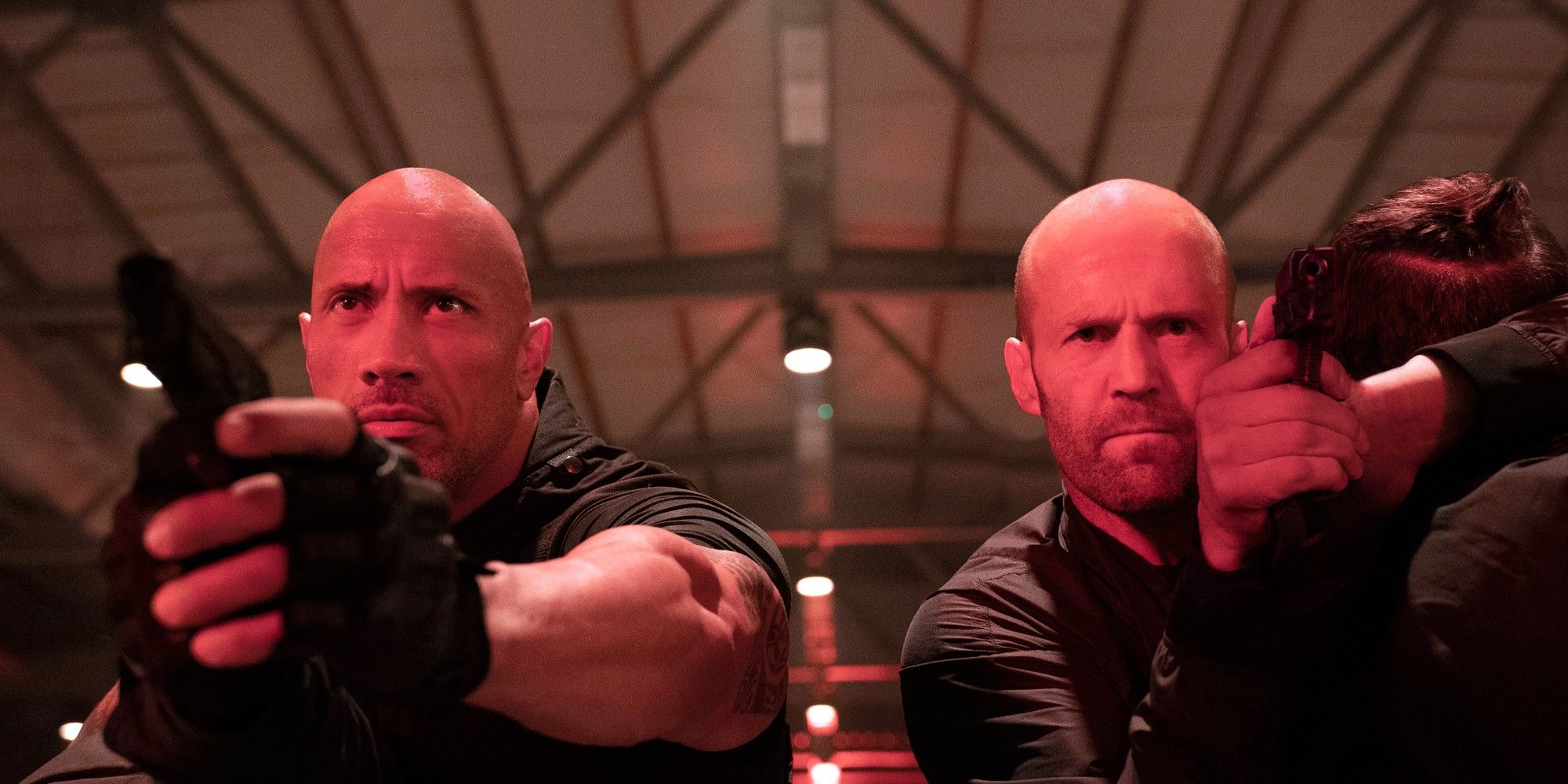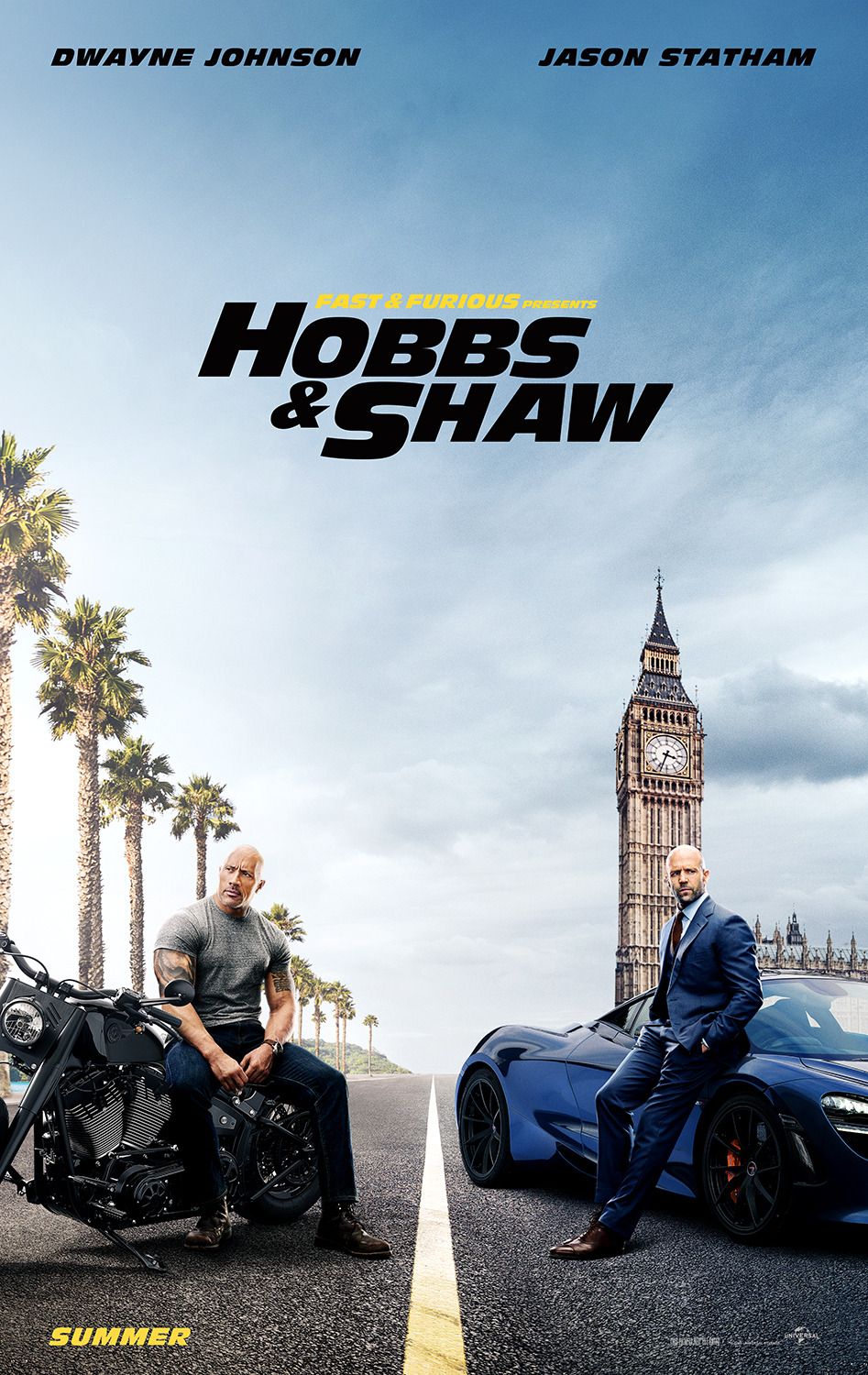Dwayne "The Rock" Johnson has shared many sides of himself with fans over the years, and even more are on display in Hobbs and Shaw. But one aspect that he has had as much of a chance to showcase in his previous Fast and Furious films is the Samoan heritage he’s so proud of. The latest spinoff, in theaters this past weekend, changes all that by placing his culture front and center for the first time ever in a big-budget live-action film. Johnson spoke with Screen Rant about how meaningful the experience was for him, as well as how his chemistry with co-star Jason Statham has grown and where he wants to see the franchise go next.
Screen Rant: Hobbs and Shaw not only explores their rivalry and partnership, but in classic fashion, their families as well. In addition to that, you were able to lay your own family history and culture into the film. Can you talk to me about threading that needle?
Dwayne Johnson: I can, thank you for bringing that up. It was very gratifying for me personally to be able to thread that needle, as you said, into the fabric of the Fast and Furious universe. And, personally, what made it gratifying to me was that this was the very first time in Hollywood history – of a movie of this size and capacity – that the Samoan culture has ever been showcased. Ever. There's been a few movies in the past, many decades ago. Small movies, maybe a documentary here and there. But really, there has been nothing. So, it was a real opportunity. I just embraced the responsibility to showcase my own authentic cultural – one of my cultures – to the world. And do it in a way that was still exciting and felt fresh to the audience.
Also, we do it in a way where the stakes are so big. The world is at stake; Jason sister's life is in danger, and it all depends upon this little island in the middle of the South Pacific. There were a lot of creative inroads that we wanted to make sure that we were tying up nicely and delivering for the audience. And also shoot it in a way that felt dynamic, that felt stylistic and cool with David Leitch’s approach to action filmmaking. He was very ambitious with the movie, which I'm sure you guys saw. And just do things stylistically, action-wise that had not been seen before. And it all happens in Samoa, which is very cool.
And then, on top of all that that I just said, the storyline of me going home to my family and to all my brothers is a very special one. And we wanted to be as authentic as possible. We hired Polynesian actors and were able to hire my own cousin, Roman Reigns. Real name Leati Joseph Anoaʻi. And that in and of itself was a whole other level of pride. The fact that he was overcoming leukemia at the time that he came on set with us; from not knowing how physical he could actually be to actually then turning into an animal on set was all very special.
Thank you for being patient with that answer. It’s a long answer that gives you an idea of just how meaningful being able to showcase the culture was, and just really how many unique layers there was to it. Finally, we’re just very happy that it worked well in the movie and audiences were digging it.
CBR: So much of the heart of the film is defined by you and Jason's back-and-forth relationship. What was it like to work with him?
Dwayne Johnson: It was great working with Jason, because we were really leaning into chemistry that kind of blossomed out of nowhere. We have worked together, obviously, in [Furious 7].
In [The Fate of the Furious], we were putting our scenes together, and I remember there was a scene where he was working on his car. And I went to him and said, “Let's change things up a little bit. I'd like to say something to you. I want to talk a little shit to you.” I said, “I don't want to tell you what I’m gonna say. I’d really love for you just to react. And how you react, you react.”
And at that time – in any movie like this, chemistry comes with trust. Trust comes with time. Just like the chemistry that I have with Kevin Hart comes from the time we’ve known each other for, 10 years plus we’ve worked together on many movies. But I had not worked with Jason before, so it wasn't like there was a lot of trust.
Jason is very regimented. He likes to say what's on the page. He reads the script, and he doesn't often like to deviate from that. I like to do that too. However, I also like to adlib, I like to reach, I like to stretch things out a little bit more to find some magic.
So anyway, I remember in Fast 8, I thought, “Let me try this.” I said, “I just want to say something to you and talk shit in this scene, and you react how you react.” So, he said, “Okay, mate. Sure.” And I said, “I promise you. Trust me, I'm not gonna hang out to dry. If it works, it should be kind of funny.”
We’re in the scene, and I remember specifically saying, “When this is over, I'm gonna knock your teeth so far down this road, you're gonna stick a toothbrush up your ass to brush them.” He looked at me and started to crack up. He broke his character, he laughed, and that’s the take that we used in the movie.
Honestly, guys, it was in that moment that this kind of unique thing happened. And then when we had our other scenes, he would come to me and say, “Dwayne, you want to say something else to me?” “Yeah, lemme say this.” And then I would say, “Well, what if you said this back to me?” And he’s like, “Oh, yeah, I love that!”
Before you know it, by the end of the movie – here’s a little inside baseball for you guys – where it’s the big dinner scene, and we’re on top of the apartment in New York on Fast & Furious 8. It got to the point where Jason and I, we’re almost shooting our own movie. The things I was saying to him in that scene, and the things he was saying to me? It’s all unusable. All on the cutting room floor, you can’t [watch it.]
But, to give you guys an example of our days, we had such a good time. And it was after that movie that Universal said they [played the] movie back, audience tested it and loved our characters together and loved what we were doing. And that was the creative inroad we needed that made sense for the spin off. And then we made Hobbs and Shaw.
So, it's part of it the chemistry now, of course. There’s a lot of trust between us, and the chemistry just explodes onscreen. And not only that, but as you guys know because you’ve seen the movie, what the spin-off allowed us to do was not only delve into the characters’ backstories. It also allowed us to have our own energy and our own tone. It allowed more comedy, more banter between the two leads. And, again, really created a pretty fun chemistry for the audience.
The Ringer: I wonder if you could maybe take me through the climactic scene at the end. Specifically the helicopter scene. I want to understand a little bit more about the way that the entire sequence was put together. Could you tell me a little about the preparation and what you're actually doing physically?
Dwayne Johnson: Sure, I'm happy to tell you about that. As we were shooting the movie, we shot pretty much in order. So, we started our movie in London. Creatively, we started our movie in London for the audience sitting in the theater, but also, we did not shoot out of sequence. We shot in London for a month, and then we had our Christmas break, and then we went to Hawaii.
We’ve shot most of the movie, and now the final act of the movie is in Hawaii, which is obviously Samoa in the movie. We knew that we had a banger of a fight scene; a triple-threat fight between myself, Idris and Jason. We always knew that was going to be our anchoring action sequence; that David had this big idea, and he was going to include all the elements. He was going to pay homage to one of his favorite directors, Kurosawa, out of Japan. So we had fire, and we had rain.
The reason why I gave you guys that context was that was the movie [script]. The big action set piece was going to be this big fight after the Siva Tau with my brothers, and we were going to go to war, and then we were going to go into the cave.
As we were making the movie, as we were shooting the third act and as we're over in Hawaii, there was something that was gnawing at all of our guts. I sat on the beach with Chris Morgan, and our writer, Hiram Garcia, our producer, and Jason. And the gnawing at the gut was, “Is there something missing?” Is there an acting element that is missing?
Because, again, the answer was like, “I don't think we’re missing anything.” But can we make it better? Can we make it unique? Is there something that we can add that’s going to give it just one more burst of power before the helicopter crashes [as we] come up on the big fight?
I give you guys all that context because it was Chris Morgan. At beginning of work the next day, he goes, “I have this crazy idea. What if they’re on the back of the Peterbilt? Jason is driving, helicopter comes with Idris, we hook the helicopter, and that’s how –“ No, I'm so sorry.
So that’s how it worked in the movie: we were on the back of the Peterbilt, and I hook the helicopter, and the helicopter [and we] all eventually crash and go down into the [?]. That was already in the movie, forgive me.
So, Chris Morgan came to set the next day and said, “What if we extended this? If we took this sequence and we turned it into a fucking insane daisy chain of cars driven by your brother, all created in the Hobbs custom workshop, in order to bring the helicopter back down?”
And it sounded great. It sounded fantastic and cool and a nice [view from] the top. And then we finally sat down and we put together some visuals of it, and that’s how that scene came to be. It wound up being just this really insane thing that keeps the audience on the edge of their seats, but also really puts our heroes in unique jeopardy again going into the third act.
So that’s how it came to be. In terms of physically, you can imagine how we shot it: outside, on the Peterbilt, holding the chain. And that's one of the fun things about a movie like this in the Fast and Furious world, that the action is so over-the-top and so absurd that I am holding a helicopter.
It's so funny, because we were talking as we were shooting the scene. The question was posed, “Is that too much?” Is it too much that Hobbs is holding a helicopter hostage? And then of course we justify it: he’s redirected a torpedo; he does things like that. I don't think it's too much if we can find a way to find humor at some point, either in the [current] sequence or certainly when we get down into the cave. Make people smile and laugh at some point.
So anyway, again, long answer. Want to give you guys all the context that I could possibly give. That's how we got into that crazy daisy chain finale that wound up being the movie’s big “holy s***” moment.
Screen Rant: What are the chances we get a Hobbs, Shaw and Locke film sequel?
Dwayne Johnson: The goal was to not only give the audience great ‘holy s***’ cameos, but also make that be an indicator of what the future team looks like. Where you have Hobbs, you have Shaw, you have Locke. You have [Kevin’s character], Air Marshall Dinkley.
And then what we also did at the end was we left the ominous voice faceless. So, for some time, I think you guys have heard the rumor that it was going to be a bit of a John Wick, all disguised. But then we left it there [with] a few people in mind. But anyway, the point is, originally Keanu was the goal. We were talking, and it just didn’t feel right creatively. He and I talked, and I totally got it. And it wound up being the best thing, so now we leave that open for the future.
CBR: One of the things that's really interesting about Hobbs is that he's kind of risen in prominence within the franchise and grown from the guy going up against the rest of the cast to now co-leading this major spin-off film. What's it been like to be a part of that?
Dwayne Johnson: It’s been really gratifying. You know, you go back to Fast 5, and my goal was to come in and create a character that audiences dug and enjoyed seeing, and to try and elevate the franchise in any way I could. And that same goal extended to Fast 6.
At the end of Fast 5, yes, we had soft-balled. But after Fast 6, the studio had come to me with a declarative, “Do you want to make a spin-off?” And I thought, “Okay, this is a great idea. What’s the overall goal?” Sure enough, they said, “The overall goal is to do Fast 7, 8, 9, 10.” I thought, “Great.” This is smart. We have these lateral spin-offs, creative new adventures and new characters. It was a great idea.
The thing was they were just having a hard time figuring out what those creative inroads were that made sense, and one of the ideas were really sticking. They were good, but they weren’t really sticking. So, we waited after Fast 7 and, of course Fast 8 was when the spin-off happened.
But it's been very gratifying. I feel like the pressure’s on for this to work, because if it does work then that means a greater opportunity for longevity for the franchise. It allows for a freshness and a unique spin; a unique identity coming off a franchise. It also creates opportunity for other actors to rise up and shine and potentially spin off as well.
So, I am a big advocate and proponent of lateral growth and doing the smart thing when it comes to trying to build a universe. Because I do feel like the goal is that with Fast 9, which we’re shooting now, and then Fast 10, you do want to spin-off. Not only Hobbs and Shaw but possibly the other characters too as well on your way to Fast 10. Making Fast 10 as great as it could possibly be.
It's taking the model, structure and strategy that Kevin Feige has done so bravely every year and applying it. We're actually doing it a little backwards. We’re a little late with the spin-off, but overall it's been great. I was given just great latitude to make the movie that I myself, Hiram at Universal, Chris Morgan, we all felt like we wanted to make and was what we envisioned.
And again, I think I mentioned this earlier, paying homage to the Fast and Furious DNA was just so important. Because they're anchoring elements that make those movies pure: family and badass car chases. Things like that, but also our own identity and our own tone. I just wanted to try and accomplish it and give audiences something that was just fresh and a different spin.
So, if it works, then that means a great [deal] not only for the franchise but also, now I want to see other opportunities for other characters. Other characters that possibly don’t exist right now, that we can create; that we tried to create obviously in Hobbs and Shaw.
Like the Locke character, check [with the fans]. You guys saw it too, if you sat in the audience. It was crazy for Ryan Reynolds to be in the movie. I’ve known Ryan for a long time – we’ve been buddies for a long time – but again, you never know what kind of chemistry is there or not there. We’d talked about doing movies in the past together, he and I. It all depends.
When he came to London and he shot that scene in the diner, and he wrote most of it. And I told him, “You have a nice sense of Hobbs’ voice; you could write it.” He did. He took that on, and he wrote my voice in that, which was great.
The first take. The very first take, they yelled action and within fifteen seconds, I remember thinking to myself, out of character, in my head, “Holy s***. There’s some really cool stuff here that we can find our way through.” That scene just really exploded, which then led to obviously the coda at the end.
So, again, very long answer to say that, yeah, I look forward to it and I look forward to that being seen in the future.
The Ringer: I wanted to go back to Samoan culture being so important to this movie. Roman Reigns told me that your mom was on set for some of those days. What was it like being on set with a lot of the Samoan brothers and Polynesian actors while you're shooting and in your downtime? Just to have their presence around you.
Dwayne Johnson: There was a lot of pride; so much pride. There's something called Poly Pride – Polynesian pride. There really was. Because all of the actors, many of whom I’ve known over the years – who aren’t actors; they are former athletes; they are Polynesian dancers; they are High Chiefs of Samoa – were all hired to be my brothers and family.
There was an extraordinary amount of pride, but there was also a feeling on set that we were all of a sudden in the trailblazing business. And what I mean by that is, there was a feeling on set for not only the Samoans and Polynesians, but the director David Leitch, our producers and actors, Idris when he came to set – everybody knew that we were doing something that had never been done before.
What had never been done before was actually showcasing our culture. So, these men and women who were on set, they were fully aware of this opportunity and fully aware of the light that was going to be shined on the culture. So, there was a real energy on set.
There was a lot of sacred ground where we shot the movie, and you could feel that [you were] on sacred ground. But when we started shooting scenes – especially when we were doing the scene about the Samoan version of the Māori Haka, and it was kind of in a war – we would hear constant war cries. We would constantly hear that throughout the night, because we had all gone down and it had felt very real and authentic to all of us.
You did mention my mom. I brought my mom to set, and she was there when we were back in Samoa in our storyline. She was so excited to come to set that night. She was sitting off to the side behind the cameras, and I start speaking in Samoan in the scene. …I’m speaking in Samoan upon calling on my ancestors for strength. And even though this is a movie, when you're saying things like that and you’re speaking to God in our culture, it’s more than a movie. You’re calling on your ancestors; you're literally standing on sacred ground in the islands.
Honestly, it really became more than a movie in that moment. Then I call on my brothers to stand up, I say, “Saʻo luga” and they all stand up. And then we start doing the Siva Tau, and the Siva Tau was put together specifically – there’s many versions you can do, just like there’s many versions of the Haka – but our Siva Tau was put together by our Samoan consultants and blessed by our elderly. And the words were put together by our consultants, so there would be some things like, ”Look into my eyes. It’s the last thing you see before you die.” Again, even though it was a movie, when you say things like that in the spirit of which we were doing it, then it becomes very real.
Then we start doing the motions of the Siva Tau. I explained to David Leitch, I said earlier, “We have to push this in a non-traditional way.” We would usually shoot it for hours and hours and hours, and you would do a hundred different takes, different angles. I said, “You have to be sensitive to what this is. And being that the Siva Tau is so real to all of us, and it requires so much energy, and it takes so much out of you, and it's really intense – emotionally intense.” I said, “We have to go non-traditional. We can't have that many takes.” And he goes, “I totally understand, brother.” And David was so respectful, he just got what he needed and then we stopped doing it.
But as we were doing it, the very first time we did the Siva Tau, I look over. Right in the middle of it, I look over at my mom, and she is bawling. She was crying so hard. In a big wide shot, your eyes can dart around a little bit. Of course, I was looking at my mom, and all of my brothers were looking at her. She couldn’t help but try and hide her emotion. Then when David yelled cut, it was a really beautiful moment. All the brothers, Roman, they all went over to her and gave her a hug and made sure she was okay. And I'm sharing that with you because you brought her up, but that moment was crystallized by her tears. But the tears were of really great pride, and it kind of ties it all back to what I talked about the beginning of our conversation. There is just such a tremendous amount of pride on set.
It was so emotional and everyone – all the actors, the Polynesians on set, the men and women – were just so grateful. When they were crying, it was again from gratitude. I think that’s the beauty sometimes about culture; it can be so powerful and so moving and so sacred.
What I also find fascinating, and we laugh about it all the time within our own families, is that Polynesian people are very large people nature. They’re just big-boned; they’re just big and badass. I like to say, “The men are big and badass, and the women are even bigger and more badass.” But then, also, there’s this really quiet, pensive side to all of us. So, it was a very special thing [to share] our culture, and I was quite happy and proud to be able to showcase it to the world. Because, the truth is, there's not a lot of opportunity out there. Not a lot of movies have been made like this, where you can breathe in a culture that has been [overlooked onscreen] since the beginning of cinema.
That’s fascinating. That’s really cool.
Dwayne Johnson: It really is. That’s why Hobbs and Shaw is deeply personal for me, not only because I really want the movie to work for the benefit of the Fast and Furious franchise that has been so good to me over the years, and the fans. But also, I want to showcase the culture that I’m really proud of – one of my cultures that has been so defining for me over the years – in a cool, big, commercial, popcorn, badass way. Then, who knows? Maybe we get to use it. Maybe we get The Rock to Samoa. Take my shirt off, do the Siva Tau, and dance with people in the streets.
That’s your next movie right there. Thank you so much for taking the time to speak with us.

